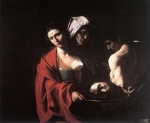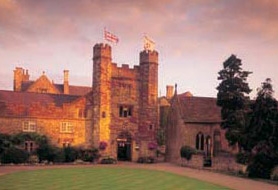 'A beautiful life is to be lived in the shadows, but with peace, order and tranquility' - these words by the painter Gwen John (1876-1939) were quoted at an exhibition about her work and that of her brother Augustus which I saw for a second time this weekend. The show was at the National Museum & Gallery in Cardiff. I was there after an idyllic family wedding at the St Pierre Hotel in Chepstow.
'A beautiful life is to be lived in the shadows, but with peace, order and tranquility' - these words by the painter Gwen John (1876-1939) were quoted at an exhibition about her work and that of her brother Augustus which I saw for a second time this weekend. The show was at the National Museum & Gallery in Cardiff. I was there after an idyllic family wedding at the St Pierre Hotel in Chepstow.
Gwen John's words fit both her work and with my experience of a quietly happy and ordered weekend in Wales. She believed profoundly that her art was integral to her faith, and in her last years produced some remarkable understated portraits inspired by a devotional image of Mère Poussepin, the 17th century founder of an order of nuns near her home in Meudon.
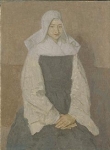 These small-scale, chalky portraits have an austere beauty. John's subjects gaze serenely out of narrowly proportioned canvases in muted greys and browns. After an affair with Rodin, the painter lived out her last years in ordered isolation in a pair of little wooden houses surrounded by green. I heard four young harp students give a recital in the gallery. Mussorgsky's Great Gate of Kiev sounded wonderfully dynamic when performed by a harp quartet, overlooked by a portrait by William Parry of his father John, 'The Blind Harper of Ruabon', (d 1782) sometimes called the father of modern harpists.
These small-scale, chalky portraits have an austere beauty. John's subjects gaze serenely out of narrowly proportioned canvases in muted greys and browns. After an affair with Rodin, the painter lived out her last years in ordered isolation in a pair of little wooden houses surrounded by green. I heard four young harp students give a recital in the gallery. Mussorgsky's Great Gate of Kiev sounded wonderfully dynamic when performed by a harp quartet, overlooked by a portrait by William Parry of his father John, 'The Blind Harper of Ruabon', (d 1782) sometimes called the father of modern harpists. 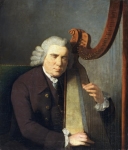
I was delighted by the empty, bright galleries with their collection of remarkable Monets, Renoirs, Cezannes and Sisleys given by the Davies Sisters of Gregynog. Paintings gave glimpses of long dead sitters' lives: the newborn, a family group by Gainsborough, August John's ferocious children, the middle-aged in their prime and Gwen John's serene elderly nuns. I watched the same life stories being told out in Cardiff's shopping streets. In the warm spring sunshine all seemed ordered and peaceful. Even the traffic moved with stately good manners.
Calm good organisation and quiet consideration seemed to mark the wedding, the official start of another couple's life together. It began with a service in the tiny church of St Peter, St Pierre, next to the hotel.
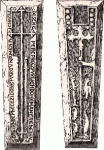 The manor of St Pierre was founded by the Normans and once briefly sheltered the crown jewels. In church the wedding party sat close-by two remarkable 13th century carved tombstones, one of which is believed to commemorate Benet, the church's first known priest. A staff sprouts leaves and is surrounded by wildlife celebrating renewal. Like generations of locals before me I touched the carving's hand that he might bring luck both to me and to the newly married couple.
The manor of St Pierre was founded by the Normans and once briefly sheltered the crown jewels. In church the wedding party sat close-by two remarkable 13th century carved tombstones, one of which is believed to commemorate Benet, the church's first known priest. A staff sprouts leaves and is surrounded by wildlife celebrating renewal. Like generations of locals before me I touched the carving's hand that he might bring luck both to me and to the newly married couple.
Gwen John at the National Museum of Wales
Tate Gallery article about Gwen John
Reviews - Page 2
-
'A beautiful life' Gwen John and a family wedding in Wales
-
Caravaggio at the National Gallery

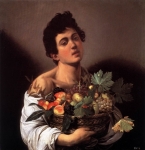 Just 16 paintings in this show, but what an impact they made. I expected the cherry ripe sensuousness of 'Boy with a basket of fruit' (1593-4) but these six dimly-lit rooms focus on Caravaggio's last four years before his death in exile aged just 39, in 1610. Comparison between two versions of the 'Supper at Emmaus', just 5 years apart, showed the transformation from richness and colour to a darker, more humane vision. Caravaggio's stunning chiaroscuro and drama that inspires film-makers like Jarman and Scorsese. In 'The flagellation' of 1607, the tension between Christ's soft submission and the hatred of his scourger is painful to see.
Just 16 paintings in this show, but what an impact they made. I expected the cherry ripe sensuousness of 'Boy with a basket of fruit' (1593-4) but these six dimly-lit rooms focus on Caravaggio's last four years before his death in exile aged just 39, in 1610. Comparison between two versions of the 'Supper at Emmaus', just 5 years apart, showed the transformation from richness and colour to a darker, more humane vision. Caravaggio's stunning chiaroscuro and drama that inspires film-makers like Jarman and Scorsese. In 'The flagellation' of 1607, the tension between Christ's soft submission and the hatred of his scourger is painful to see.
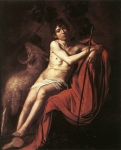 'Saint John the Baptist' of around 1608 had a knowing, sad eroticism that shifted the focus between the saint and Caravaggio's street-boy model. In his last days Caravaggio was a hunted man. He bought his way out of prison and used membership of the Order of St John in Valetta to buy the Pope's pardon.
'Saint John the Baptist' of around 1608 had a knowing, sad eroticism that shifted the focus between the saint and Caravaggio's street-boy model. In his last days Caravaggio was a hunted man. He bought his way out of prison and used membership of the Order of St John in Valetta to buy the Pope's pardon.
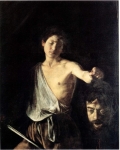 Smooth perfectionism gives way to looser brushwork and less formality. The painter sometimes depicts himself as a hunted creature or as a seeker of absolution, or even (perhaps) as the dismembered head in 'David with the head of Goliath' (1606-10). After this period of intense creativity, Caravaggio died of fever, chasing after the ship that carried away many of his last works. The power and intensity of these last paintings, several of them on a huge scale that would show poorly here, stunned me. Attempts at analysis seemed superfluous. Nothing to do but drink them in.
Smooth perfectionism gives way to looser brushwork and less formality. The painter sometimes depicts himself as a hunted creature or as a seeker of absolution, or even (perhaps) as the dismembered head in 'David with the head of Goliath' (1606-10). After this period of intense creativity, Caravaggio died of fever, chasing after the ship that carried away many of his last works. The power and intensity of these last paintings, several of them on a huge scale that would show poorly here, stunned me. Attempts at analysis seemed superfluous. Nothing to do but drink them in. -
Lempicka on Dr Who
 I was ludicrously pleased to spot a version of Tamara de Lempicka's unfinished portrait of Tadeusz de Lempicki featuring in Episode 6 of the new Dr Who. Her heroic, geometric style was perfectly suited to a portrait of the nasty Geocomtex boss Henry van Statten, played by Corey Johnson.
I was ludicrously pleased to spot a version of Tamara de Lempicka's unfinished portrait of Tadeusz de Lempicki featuring in Episode 6 of the new Dr Who. Her heroic, geometric style was perfectly suited to a portrait of the nasty Geocomtex boss Henry van Statten, played by Corey Johnson.
 The 1928 original is in the Musée Georges Pompidou in Paris, but featured in the Royal Academy's terrific Lempicka show last year. Van Statten's look seemed to have been influenced by another striking de Lempicka portrait, of Dr Boucard, her Swiss Chemist patron. I'm almost a complete convert to Christopher Ecclestone as the Doctor, even down to his street-wise northern grittiness, though quite where the great Gallifreyan got his Manchester accent is beyond me.
The 1928 original is in the Musée Georges Pompidou in Paris, but featured in the Royal Academy's terrific Lempicka show last year. Van Statten's look seemed to have been influenced by another striking de Lempicka portrait, of Dr Boucard, her Swiss Chemist patron. I'm almost a complete convert to Christopher Ecclestone as the Doctor, even down to his street-wise northern grittiness, though quite where the great Gallifreyan got his Manchester accent is beyond me.
See http://www.goodart.org/artoftdl.htm for more on de Lempicka (1898-1980)
-
Twilight of the Gods, ENO
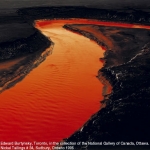 'What use is my wisdom against this chaos?' sings Brünnhilde in Phyllida Lloyd's production of 'Twilight of the Gods' at the Coliseum in London. After almost six hours of climactics, Wagner's Ring Cycle ends as Brünnhilde immolates herself together with the cursed ring of the nibelung which is to be purified by the same fire that will take her to her beloved Siegfried.
'What use is my wisdom against this chaos?' sings Brünnhilde in Phyllida Lloyd's production of 'Twilight of the Gods' at the Coliseum in London. After almost six hours of climactics, Wagner's Ring Cycle ends as Brünnhilde immolates herself together with the cursed ring of the nibelung which is to be purified by the same fire that will take her to her beloved Siegfried.
This was the first time I had seen more than 'the Valkyrie', the second in the cycle. That production in Budapest stunned me, every emotional nuance of the characters seemingly mirrored by the wonderful expressiveness of the orchestral writing.
The ENO production has been more controversial. I sent my sister to the much shorter 'Rheingold' - number one in the cycle - as her introduction to live opera. She and her husband loved the music and the light-hearted staging.
Traditionalists found plenty to gripe at: Wotan seem to have been partly inspired by Ozzy Osbourne and we saw him in the bath. A soap opera in every sense. On balance, I enjoyed the 'home life of the immortals' staging. The non too subtle story was that the Gods have crises just like characters in 'Eastenders'.
Even so, a measure or two tragic grandeur in the final part of the Ring seemed essential, even for the most contemporary of productions. Act one, the longest at over two hours, began with the lady norns getting their knitting of time in a twist. The Rhinemaidens pole danced again and the valkyrie were encouragingly punky (as seen at last year's Glastonbury Festival). But the singing lacked oomph, wicked Hagen was off-key and Siegried was underwhelming.
It got much better in the second and third acts. Siegfried's death and funeral march and Brünnhilde's burning were terrifically involving. The Rhine rose to cover her ashes and Valhalla fell with three vast shimmering golden curtains and a fade to black.
Powerful stuff and far too complex for me to fully comprehend after just one performance. The sensual, amoral music thrilled me but the performance lacked the devestating impact I hoped for. Am I becoming jaded or can the English not do Wagner? -
Akram Khan in 'Third Catalogue', Purcell Room, 14.4.05
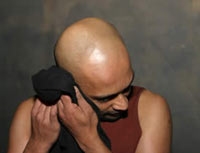 The final part of kathak dancer Khan's trilogy of solos on the South Bank. Central solos from the first two parts of his trilogy, Polariod Feet and Ronin plus a new solo. Khan on stage with five musicians, including singer Faheem Mazhar and BC Manjunath, the percussionist from his company's current touring show, 'ma'.
The final part of kathak dancer Khan's trilogy of solos on the South Bank. Central solos from the first two parts of his trilogy, Polariod Feet and Ronin plus a new solo. Khan on stage with five musicians, including singer Faheem Mazhar and BC Manjunath, the percussionist from his company's current touring show, 'ma'.
A performer whose work has consistently mesmerised me, not just because of his compelling stage presence, but also because of his very evident deep commitment to his art. In an interview in 'The Times', Khan describes his work as 'an offering', meaning that it is to be read as an expression of his spirituality. That intense feeling moved me, but there was also wit and wonderful precision. Khan held the stage with beauty and astonishing control. He has the ability to switch seamlesly from the most rapid and energetic movement to one of langorous delicacy, and this was especially visible in his first solo, which depicted the duality of the male and female principles in Hindu Gods.
In the second half Khan came to the microphone to gently teach the audience about kathak. Compelling improvisations followed, with the joyful collaboration of his musicians.
His next contemporary performance will be 'Zero Degrees', a collaboration with Anthony Gormley at Sadler's Wells next July. In 2006 he will dance with Sylvie Guillem.
Times article -
Rebecca in Cambridge

Seen at Cambridge Arts Theatre, 12.3.05.
'Last night I dreamt I went to Manderley again'. Du Maurier's novel makes an enjoyably gripping play in this new adaptation by Frank McGuinness. It begins with the second Mrs Maxim de Winter alone on a beach of white stones, with a projection beyond of breakers running in to shore. Through the projection a dim yellow light picks out the features of Mrs Danvers climbing a great stair. She is fetishistically, erotically obsessed with her lady Rebecca, the first Mrs de Winter. There is an over emphais on sexual deviation in the play: a young footman likes make-up and ginger beer, and the estate manager was almost gay (played by family friend Martyn Stanbridge).
Nigel Havers was excellent as de Winter, and Danvers was brilliantly played with steely focus by Maureen Beattie. There were rather too many laughs in the first half and perhaps the menace grew more slowly than du Maurier might have wished in the second.
A great delight to see such a lavish, well-cast show running with precision. In the final scene the beach becomes blazing coals as Manderley is destroyed by fire. It made a juicily satisfying ending to the evening's entertainment.The houses are record-breakingly good, the cast have incredibly been given a pay rise, and everyone goes home happy. -
Britten's War Requiem: semi-staged
At Pangbourne College Falklands Chapel last weekend.
A youth, sepulchre-white and bare-chested, was borne in on the shoulders of his equally floppy haired pals.
Two male soloists spent the performance on a scaffolding tower, one had a glitter ball for company, the other the pale (and still shirtless) boy. The tenor needn't have worried as he had his time later, when the youth popped up on his tower (looking for someone to light his candle). When the soprano had to sing Rex tremendae maiestatis the single follow spot (which had been pursuing her all evening) obliged by tremulously expanding and contracting all over her. Too many excitements, really - very camp. In his madder moments Britten might have approved but I rather doubt it. More's the pity as all this pantomime distracted from the fine music, which was well played.
